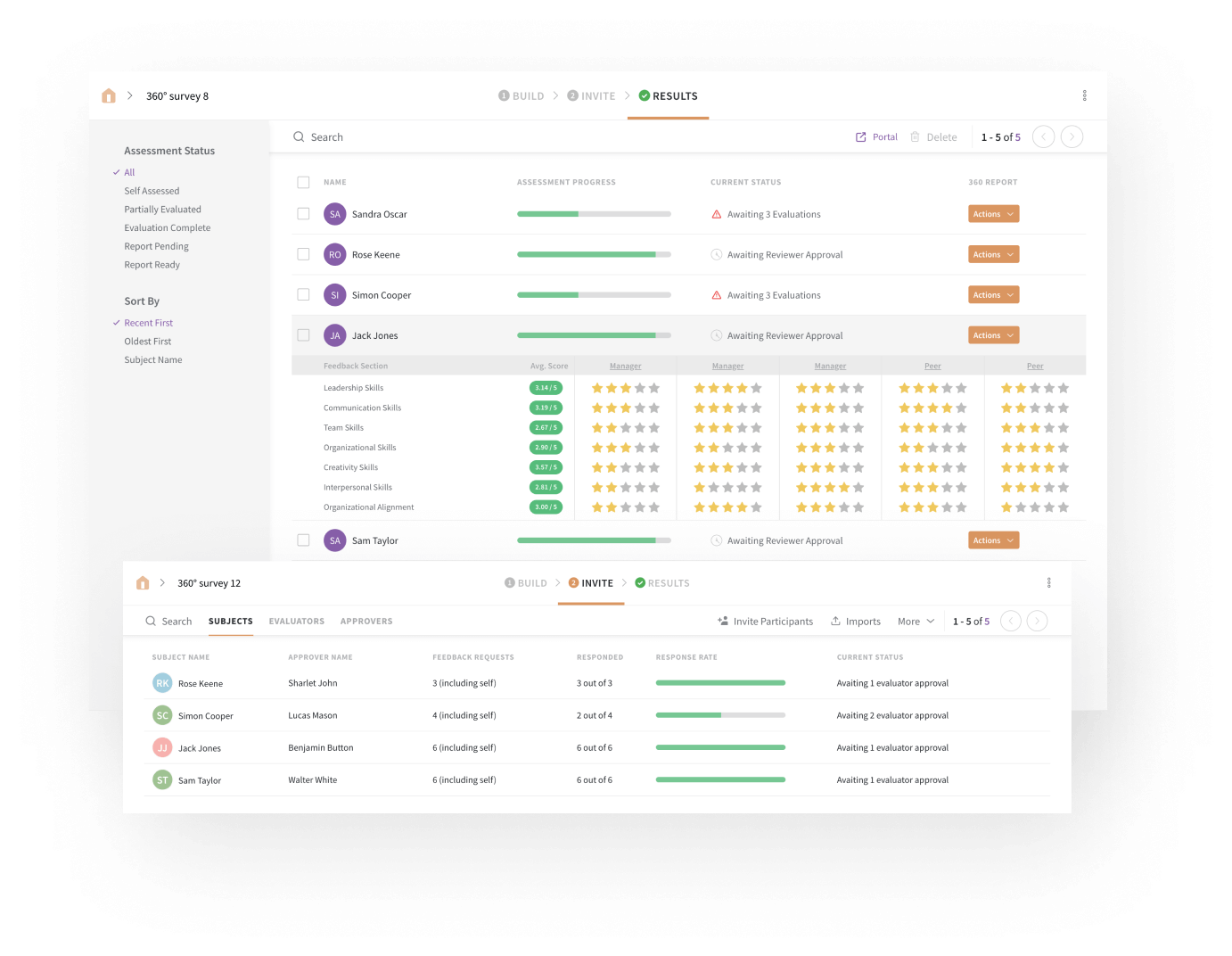Employee Experience
Top 360 Degree Feedback Examples for Peers
Article written by Kate Williams
Product Marketing Manager at SurveySparrow
16 min read
19 September 2025

60 Seconds Summary:
Welcome to our guide on 360-degree feedback examples. If you want to that drive growth with feedback, you're in the right space. At SurveySparrow, we believe feedback isn't just about pointing out areas of improvement; it's all about having a culture of continuous development and mutual respect. In this article, we will understand into two core types of feedback: reinforcing and redirecting. Reinforcing feedback celebrates achievements and encourages the continuation of positive behaviors, while redirecting feedback offers constructive suggestions for improvement. By mastering both, you can provide balanced, actionable insights that empower your colleagues and enhance team dynamics.
Ready to elevate your feedback game?
Are you looking to give effective 360 degree feedback that actually drives improvement? Need practical examples that make your feedback more impactful?
When teams give and receive honest feedback, everyone grows. The challenge that most organizations face is a lack of a structured approach to communicate these insights effectively.
A simple tool can help you change that: 360 degree feedback.
This 360 degree feedback can help you improve your workplace culture, improve employee engagement, and significantly reduce turnover.
In this blog, we will discuss:
- 360 degree feedback examples that will help you give healthy feedback to your co-workers
- The definition of 360 feedback
- The need for 360 feedback examples
- What to include in 360 degree feedback
- Checklist for writing thoughtful 360 degree feedback
Effective 360 Degree Feedback Examples
It has been known for a while now that 360 degree evaluation is an exercise any organization should conduct regularly.
There are many benefits to 360 assessments. Concretely, these exercises have been shown to improve employee engagement and reduce employee turnover. Imagine getting a feedback like this:
Your contribution to the team is immense and wholesome. The passion you put into everything you do is a source of inspiration to us. Keep inspiring!
Won’t you be excited? First things first, you’ll need a 360-degree feedback software that works right for you. Worry not, we come with a solution.
From new hires to management, sign-up for FREE to set up a 360-degree feedback system with ThriveSparrow.
Feedback examples will help you fill those surveys with ease and communicate your feelings effectively.
Like in life, there are two kinds of feedback you can give in 360 degree feedback surveys. Usually, feedback is categorized as positive or negative. A better way to categorize feedback, though, is as reinforcing or redirecting employee feedback.
This removes the stigma around feedback and helps you focus on the intended consequence of the feedback. Here are some examples of both kinds of feedback.
#1. Reinforcing 360 Degree Feedback Examples
Like you must’ve guessed from the name, reinforcing feedback is given when we want the manager or employee to keep up the work they’re doing.
Reinforcing feedback is powerful, and often motivates employees to turn in high standards of work.
Here are a few different kinds of reinforcing employee feedback –
1. A Coworker Passed A Big Milestone
Has your manager or employee just passed a big milestone at work? Have they surpassed a goal or met a difficult challenge? It’s important to turn that into an opportunity to appreciate that and congratulate them.
As a 360 degree feedback example, you can write,
“Congratulations on passing [insert milestone]! Because of your great work, we have been able to achieve [insert business goal]. Your passion and commitment are greatly appreciated.”
Remember, if there are any concrete examples you can give about how their achieving this goal has helped you, insert them. Example-driven feedback is the best kind.
2. A Coworker Takes Initiative
Few things are more important to an organization than employees who take initiative. Too often, employees start off with a lot of drive. Over time, though, their engagement levels start to stagnate.
One way to encourage employees to take initiative is to appreciate them when they do. 360 degree evaluations are a great place to do that. As a 360 degree feedback example, you can say –
“Thank you for taking the initiative recently to [insert initiative]. Your leadership really helped us get ahead in this project. Keep it up!”
When you specifically tell managers or employees that their initiative-taking approach is great, that will reinforce that behavior. It’s a great idea to use a 360 degree assessment to make this effort.
3. A Coworker Helps You Or Other Employees
One of the best things about working in an organization is that you get to be part of a team. But in a good team, teammates actively help each other get better and achieve things. Encouraging good behavior is hence very important.
When you notice that an employee went the extra mile to help you or someone else, point that out. As a 360 degree feedback example, here’s what you can write –
“Thank you for going the extra mile and helping Tim with his orientation process. You made him feel like part of the team. Your efforts help us do great work together!”
Once your coworker gets this feedback, they will feel proud of their behavior and try to replicate it whenever possible. That’s the magic of reinforcing feedback.
4. A Coworker Needs A Confidence Boost
Sometimes, we mess things up. It’s inevitable, and it happens to everyone. You might think that that’s a situation where you need to give redirecting feedback. Sometimes, that’s a mistake.
When an employee clearly knows they made a mistake, it’s no use repeating that to them. What they might need instead is a confidence boost. Use this opportunity to point out something positive. In your 360 degree feedback survey, here’s what you can say –
“You had a really great presentation prepared for our client meeting. It’s okay that you got nervous and forgot some details. Everyone could see that you had put in effort into that presentation!”
Offering such a boost when an employee needs it will go a long way. It shows that you care about the well-being of your employees, not just results.
5. A Coworker Comes Up With A Great Idea
One of the most fulfilling things about a job for any employee is to make a unique contribution to it. It takes a lot of courage for employees to trust their ideas and advocate for them. Support them when they do.
If an employee makes the effort to research and brainstorm a good idea, compliment them regardless of whether it gets implemented. Here’s an example of how you can do it in a 360 degree evaluation –
“Your idea at yesterday’s meeting was great, and it might just help us boost our sales this quarter. Thank you for putting in the research and engaging so creatively with our problem. You inspire others to do the same.”
This is great reinforcing feedback. It will create a culture in your organization of employees engaging with challenges and coming up with good ideas.
Related: How to create a thriving workforce with 360 assessments
#2. Redirecting 360 Degree Feedback Examples
Appreciation is powerful and helps maintain thriving workplace culture. But sometimes, we need to have hard conversations. 360 degree feedback surveys do a great job of facilitating that.
While the feedback is anonymous, you are still talking to another human who has feelings. It’s important to respect them while giving feedback. Here are some redirecting 360 degree feedback examples to help you out.
1. A Coworker Missed An Important Deadline
For an organization to work efficiently, people need to do their work on time. Sometimes there may be challenges in their way, but employees can also get complacent to deadlines.
If it’s your suspicion that a team member or manager is routinely late without excuse, it’s worth pointing it out. Here’s a 360 degree feedback example of how you might do that –
“Your delay on this deadline really caused us problems in finishing the next steps. We weren’t planning on taking so long with this. Could you make sure you follow the deadline in the future or let us know beforehand if you can’t?”
There’s no harm in leaving such feedback. It’s focused on the future, and it aims to redirect your coworkers’ behavior. The part about focusing on the future is critical. In your 360 degree feedback, want to make sure to focus not on negative traits but on how to overcome them.
2. A Coworker Seems Disengaged
Good work happens when employees are invested in their work and pay attention to getting it right. When they get complacent and are increasingly disinterested, that can be a problem.
You don’t have to jump the gun if that happens. Employees may be going through problems in their personal life that make them disinterested in work. But if it’s a pattern, it’s important to draw a line somewhere.
If you do have to tell them to be more involved at work, a 360 degree feedback example would look like this –
I’ve noticed that you’re not engaged lately. It’s important to us that you are motivated and enjoy your work. Your low morale is impacting the team as well. I hope everything is okay. It would be great if we can all try to be more engaged if possible. Please reach out to us if you need help with any challenges you’re facing.
This is an empathetic yet firm response. If an employee is facing personal challenges, they will be reminded to deal with them more actively. Else, it’s a good wake-up call.
If low engagement is a pattern within your organization, it might be worth conducting a full-blown employee engagement survey as well.
3. A Coworker Is Not A Team Player
Some employees don’t naturally work well in teams, while others seem to thrive on teamwork. It’s important to respect each person’s preference. At the same time, we should emphasize the need for some flexibility.
If an employee insists on working alone and doesn’t reach out for help nor offers it, they’re not being part of the team. That’s not good for the employee or the organization. Here’s how to bring it up as a 360 degree feedback example
“It’s great that you solve problems by yourself and move ahead! But sometimes, we all need some help, or we may be in a position to help others. It’s important to grab these opportunities to seek or give support. That’s how we can all thrive as a team.”
This 360 performance review helps by explaining to the employee that they need to adapt, without saying that their tendency to work alone is a negative trait. That’s what makes it a great redirecting 360 degree feedback example.
4. A Coworker Does Not Communicate Enough
Communication is just something that comes more easily to some than to others. While it’s healthy to accept that, teams need to keep pushing all employees to communicate their ideas.
When an employee routinely does not speak at team meetings, organizations lose out on important perspectives and suffer as a result. A 360 performance review is a great time to bring this up. Here’s a 360 degree feedback example for this situation –
“You’re doing great work! But I’ve noticed that you tend to stay silent in all our team meetings. Are you facing challenges with communicating? Please reach out if you do. Your perspective is important to us and we want you to feel free to contribute.”
If a criticism can be framed as a personal development goal, do that! Often, employees’ interests are aligned with the company’s in this manner. Overcoming such hurdles helps the employees personally as much as they help the organization.
5. A Coworker Is Routinely Late
There’s a reason that employees are asked to report to work at a certain time. It’s just easier for teams to start work if everyone’s around when they need to be.
Of course, personal life can, at times interfere with employees’ ability to show up on time. But if it’s a routine thing, it’s important to bring it up. It’s possible to do this in a 360 performance review without sounding petty. Here’s a 360 degree feedback example to help out –
“You’ve been doing some great work recently! I do feel though that it would help us all out if you could come for work sooner. As a team, it’s easier to coordinate if everyone is here on time. Plus, it’ll also help you maintain better work-life balance!”
It’s a slight nudge, but bringing this up in a 360 performance review is enough to create a huge impact.
How to use 360-degree feedback examples?
Remember, the example comments in this article serve as a reference and source of inspiration.
- Use them as a starting point to craft thoughtful and customized feedback.
- Adjust the sample comments based on your relationship with the recipient.
- Use these comments as conversation starters during feedback discussions.
- Use the comments to suggest resources or strategies for employee development.
What Is 360 Degree Feedback?
Before we get to the 360 degree feedback examples, it’s important to understand what this online survey tool is all about. 360 degree feedback is a process in which employees get together to give feedback about their coworkers’ behavior and performance. It can also involve employees submitting self-assessment reports.
360-degree evaluations usually include questions with rating-format answers. They also allow space for descriptive feedback. The results of the online survey are then compiled and presented to the employees.

- Each employee gets to know roughly what the people they work with think about them.
- Anonymous Surveys: Employees can know how they’re performing without any individual having to offend them with critical feedback.
- 360-degree evaluations offer a powerful solution to the tricky challenge of getting employees on the right track.
- Managers can use this tool to get a 360-degree assessment of their performance and the impact they have on their coworkers. Usually, a single manager or employee will get feedback from eight to twelve other employees.
- They will also be able to access their own self-assessment.
First things first, you’ll need an employee management software like ThriveSparrow to create employee 360-degree feedback surveys.
Why The Need For These 360-Degree Feedback Examples?
Employees are almost always invested in improving their behavior and quality of work at the workplace. There is nobody better at identifying their problem areas than the people they work with.
So it’s simple, right? They should just ask around? No. Giving and receiving good feedback is a very tricky exercise.
People get overly critical while giving feedback or defensive when they get it. This is not something we’re equipped to deal with in a healthy way.
Online survey tools like SurveySparrow solve this problem by facilitating 360-degree evaluations.
Employees are allowed to give feedback anonymously to their peers. But there’s a right way to participate in 360 degree feedback surveys and a wrong way. That’s where these 360 degree feedback examples come into play.

Usually, 360 degree evaluations are conducted only for senior managers within an organization. After all, they are the ones engaging with multiple employees who can give useful data on their performance.
The evaluations received as part of the 360 degree feedback are very influential for employees. They often lead employees to change their behavior in a positive direction.
For this to happen, though, employees need to give feedback effectively and in a healthy, positive spirit. That’s why it’s important to go through some 360 degree feedback examples.
What should I include in 360 feedback?
- Start by recognizing their strengths and positive qualities, highlighting specific areas of excellence.
- Identify specific areas for improvement and offer constructive feedback for their development.
- Provide behavioral examples for your observations.
- Discuss the impact of their actions on the team and work environment, emphasizing both positive contributions and areas for growth.
- Offer actionable suggestions for their improvement.
- Express support, confidence, and encouragement for their growth.
- Foster a two-way conversation by inviting their perspective and openness to ongoing feedback.
Checklist for Writing Thoughtful 360-Degree Feedback
- Get all the info: Make sure you have enough details about the person’s performance, skills, and behaviors. Talk to others, observe them firsthand, and gather all the necessary information.
- Be specific and fair: When giving feedback, be specific and give examples to back up your points. Stay objective and avoid making general statements.
- Balance the good and the areas to improve: Recognize their strengths and achievements alongside the areas where they can improve. Give constructive suggestions on how they can grow and develop.
- Keep it respectful and clear: Use language that is clear, respectful, and easy to understand. Don’t be harsh or attack them personally. The goal is to motivate and encourage growth.
- Offer actionable advice: Give them practical recommendations they can act on. Provide resources, strategies, or suggestions for development.
By following these steps, you can ensure your 360-degree feedback is thoughtful, helpful, and supports the individual’s growth.
Wrapping Up
Those were some reinforcing and redirecting 360 degree feedback examples. We hope these examples showed you that 360 degree feedback is a great opportunity for communication. With a little tact, you can nudge your team members in the right direction.
The problems we looked at are not trivial issues. They are critical problems that can make or break your workplace culture. It’s important to develop healthy habits and root out problem areas. That’s how organizations grow and thrive.
Online survey tools like ThriveSparrow offer great 360 performance reviews to facilitate this communication exercise. With ThriveSparrow’s templates and easy UI, creating and sharing 360 performance reviews takes a few clicks. To add to that, surveys created on this performance management software even get 40% more responses.
Back to the point, though. A 360 performance review is simply an exercise every organization must conduct. It goes a long way in improving your internal communications and consequently increasing employee engagement.
Make 360 degree feedback a regular part of your work culture, and help your employees and your company reach greater heights!

Get upto 40% more responses on your employee surveys. Start your free trial today!
Kate Williams
Excels in empowering visionary companies through storytelling and strategic go-to-market planning. With extensive experience in product marketing and customer experience management, she is an accomplished author, podcast host, and mentor, sharing her expertise across diverse platforms and audiences.
Frequently Asked Questions (FAQs)
Most organizations find quarterly or semi-annual assessments most effective, with more frequent informal feedback in between.
While 360 feedback can inform performance discussions, it’s typically most effective when focused on development rather than evaluation.
Aim for 8-12 respondents to ensure a balanced perspective while maintaining anonymity.
Guarantee anonymity, provide clear examples of constructive feedback, and demonstrate that feedback leads to positive change.
Related Articles

Employee Experience
10 Best 360 Feedback Tools to Look For in 2024
14 MINUTES
6 November 2019

Employee Experience
Employee Performance: 30 Helpful Techniques to Boost It in 2024 and Beyond
15 MINUTES
6 June 2020

Employee Experience
Losing Sleep Over Your High Employee Turnover? Here’s What You've Been Doing Wrong.
11 MINUTES
28 August 2018

Employee Experience
Navigating Success through the 360-Degree Feedback System: A Comprehensive Guide
7 MINUTES
30 May 2023
